Just a few years ago, Facebook used dual socket Intel Xeon L5520 servers to scale their infrastructure. The company put many thousands of dual Intel Xeon L5520 servers in production, and those servers are being replaced by the OpenCompute based servers. From what we can unofficially tell, the Facebook OpenCompute Intel v1 motherboard with 18 DIMM slots replaced the Dell C1100 armada of systems now on the off-lease market. The other popular version was the Dell C6100 XS23-TY3 that we have seen several times although these gain compute density while sacrificing 6 DIMM slots per node (12 v. 18.) It turns out, the low power Intel Xeon L5520 chips are selling consistently for under $40 and that there are many thousands of them in inventory. The Intel Xeon L5520 chips are around $35 on ebay which is a fairly reasonable price. Let’s see how they compare in our Linux benchmark suite and against the cloud servers we have been testing from Amazon AWS and Rackspace.
Test Configuration
To test the single and dual Intel Xeon L5520 configurations we ended up using a trusty Dell C6100 XS23-TY3. Both nodes were identically configured except for the number of Xeons in each node. Just as a note, one will notice that the results are very similar. We quadruple checked BIOS settings as can be seen below:
Each node had:
- CPU: Single or Dual Intel Xeon L5520
- Memory: 24GB DDR3 1333MHz (6x 4GB RDIMMs) in dual processor config, 12GB in single
- OS drive: Samsung 840 Pro 256GB SSD
- OS: Ubuntu Server 12.04 LTS
Aside from the SSD, this was a very common configuration. Time for the numbers!
Single v. Dual Intel Xeon L5520 v. Cloud Benchmarks
We are utilizing our new Linux benchmark suite and Ubuntu Server 12.04 LTS to take a look specifically at the compute performance of these instances. We now have a fairly broad range of Amazon and Rackspace cloud instances benchmarked along with many dedicated platforms. One may see data bars where there is no system sitting at the maximum value. This is because we tend to benchmark ahead of publication so there are many dedicated platforms benchmarked but not published yet.
Hardinfo Performance
hardinfo is a well known Linux benchmark that has been around for years. It tests a number of CPU performance aspects.
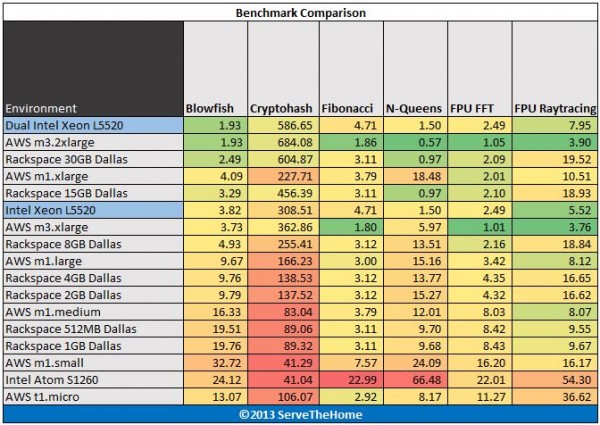
Here we see the dual Intel Xeon L5520 pull away from the single processor configuration in the multi-threaded benchmarks. The single processor configuration is about middle of the pack in terms of cloud instances. Not bad for a sub $35 processor. The dual Intel Xeon L5520 configuration also performs well against the larger cloud instances.
UnixBench 5.1.3 Performance
UnixBench may be a defacto standard for Linux benchmarking these days. There are two main versions, one that tests single CPU performance on that tests multiple CPU performance. UnixBench segments these results. We run both sets of CPU tests. Here are the single threaded results:
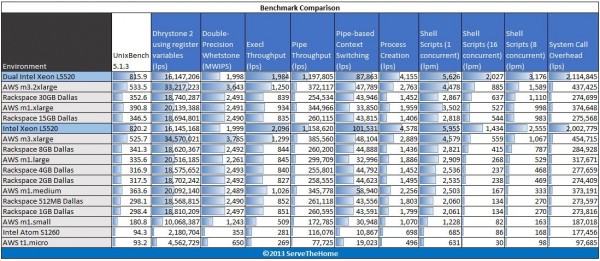
This is an interesting test as there are clearly some instances where even the paltry 2.26GHz Nehalem era single core performance simply trounces what we see from the cloud servers. We also see consistency in the single and dual processor configurations because this is a single threaded test. Let’s take a look at the multi-threaded performance:
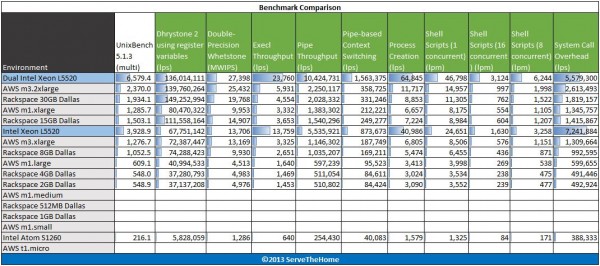
When it comes to multi-threaded UnixBench performance, the dual Intel Xeon L5520 and single CPU versions perform very well as compared to their cloud counterparts. The Amazon AWS EC2 instances and the Rackspace cloud instances are clearly struggling to keep up. Also interesting here is that the single Intel Xeon L5520 is significantly faster than this year’s Intel Atom S1260.
c-ray 1.1 Performance
c-ray is a very interesting ray tracing benchmark. It provides both consistent results and some clear separation. Ray tracing is generally a great multithreaded CPU benchmark. For this test we use both a simple 7500×3500 render and a more complex 1920×1200 render. Here are the Intel Xeon L5520 servers running the benchmark:
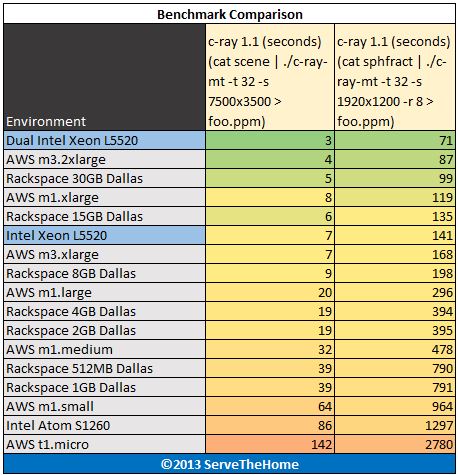
In the c-ray 1.1 ray tracing benchmark we see a similar trend but the Amazon AWS EC2 and Rackspace instances fare a bit better against the single Intel Xeon L5520. Dual processors though provide a level of performance beyond what either cloud solution is providing with the tested instances.
Crafty Chess Performance
Crafty is a well known chess benchmark. It is also one where we saw issues last time with the Phoronix Test Suite and running on ARM CPUs. Here are the Crafty Chess results from simply running “crafty bench”:

Since we are testing a core’s performance, both single and dual Intel Xeon L5520 instances perform about the same.
Phoronix Test Suite Performance
We are using four tests from the Phoronix Test Suite: pts/stream, pts/compress-7zip, pts/openssl and pts/pybench.
- STREAM by John D. McCalpin, Ph.D. is a very well known benchmark. So much so that the benchmark is highly optimized when results are presented. Vendors use the STREAM benchmark to show architectural advantages. Needless to say, oftentimes these results are hard to reproduce unless one is trying to squeeze every ounce of performance from a machine they are optimizing for. Since the rest of the industry does that, we are taking a different approach. One installation run across all systems. For this we are using the Phoronix Test Suite version pts/stream. Specifically we are using the lowest bandwidth figure Triad test to compare memory throughput.
- 7-zip compression benchmarks were a mainstay in our Windows suite so we are including it again on the Linux side as a compression benchmark.
- The pts/openssl benchmark is one we found a small issue on with the Amazon AWS EC2 t1.micro instance earlier. The micro instance had nice burst speed but fell off dramatically after that. Looping the test gave consistent results.
- Python is a widely used scripting language. In fact, it is arguably becoming even more popular these days so we decided to include a pyBench benchmark in the results.
Here are the results of the Phoronix Test Suite benchmarks:
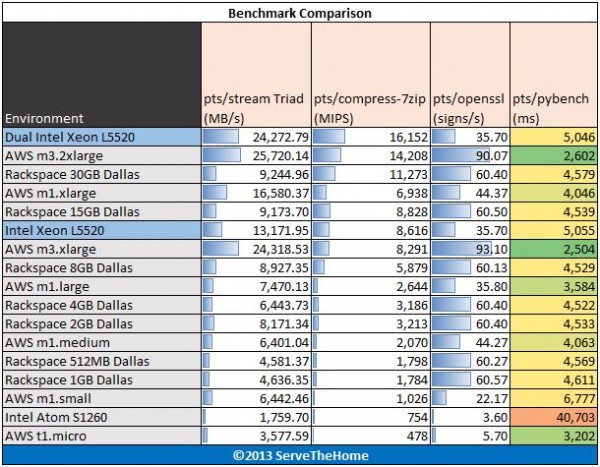
An interesting note here is that the Amazon AWS EC2 m3 instances were both based on Intel Xeon E5-2670 processors. In terms of raw memory bandwidth the shared cloud infrastructure allowed about the stream triad performance of the dual Intel Xeon L5520. The second generation EC2 m3 instances also did well in the openssl and pyBench tests.
Conclusion
First off, there are many processors today that run much faster than an Intel Xeon L5520. When one looks at power consumption there are also many platforms that use less power. With that being said, at under $200/ node with a Dell C6100 or under $330/ node with 24GB of RAM and dual L5520’s in a Dell C1100, these are very inexpensive servers in terms of up-front costs. As an interesting point, an on-demand Amazon AWS EC2 m3.2xlarge instance costs $1/ hour to run. So within three days the initial purchase price of the ($35 on ebay) CPUs is made back, and in many cases with much higher performance. These platforms are going to be of limited use in a three year timeframe, but given current pricing, the Intel Xeon L5520 is certainly a bargain.

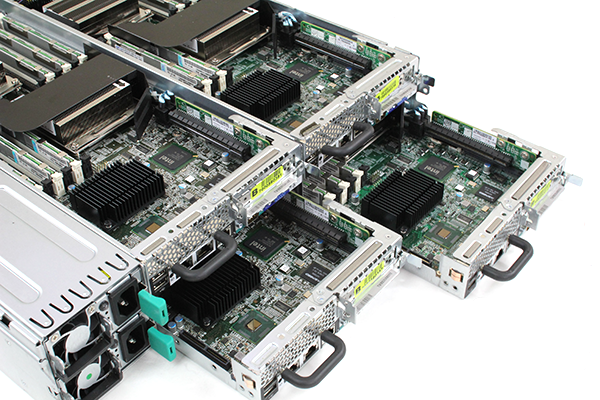

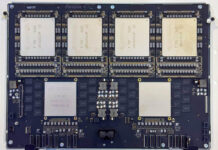

Patrick, What is the sorting logic on the graphs? I love the new details you are providing in the benchmarks, but I have a tough time reading a lot of the results.
Hi James. Using c-ray to sort the spreadsheet as it is very consistent. Still well under half of the results we have accumulated are in the above results. I do have an action item to make this better though.
I just turned one of the C6100 boards into a Hackintosh.
Pretty easy – works out of the box (although with hideous speed onboard graphics).
Needs a kext for the 82576 (Apple IGB.kext from sourceforce), but otherwise everything just works. Liked it so much, I bought another one to hackintosh (that makes 6 I own now, including the 4 in the c6100 chassis I’m busy Xen Cloud’ing).
Source Forge – autocowrong dinged me again, grrr.
Driver here – osx86drivers.sourceforge.net/
Hi, Patrick. Thank you for an amazingly informative, well written site.
I do systems biology by day and need a small HPC cluster at home. The workload is multiprocessing floating point with Grid Engine handling the scheduling and various multiprocessor aware software schemes. To get started, I had been contemplating building 2 E3-1240 V3 nodes which seem like they will cost ~$900 each (supermicro motherboards w/32GB memory in a cheesy case, no HDs).
Looking at your articles and ebay, it seems like one of these with 192GB can be had for ~$1200 (no HDs) with each of the 4 nodes more-or-less the equal of a E3-1240 V3, except for the extra 12GB, which is a plus for my workloads.
The only downside I can see is the extra ~100 watt per node and the noise. It seems like I can park these in the basement or attic and swap out the fans to deal with the noise.
100 watts per node works out to $166/year 24×7 at my $.19/KWH rate, so it seems like it will be ($900-$300)/$166 = 3.7 years until I reach the point where I might start wishing I had gone with the E3-1240 V3’s.
Does that sound right? Or is there some other reason you think I will wish I had gone with the E-1240 V3’s?
Thanks again, George
Hi George. Sounds about right in terms of power. Also, there are some inexpensive L5639 systems out there which would give you significantly more compute power and have a more modern instruction set.
Feel free to ask folks in the forums. They are amazing at finding good deals on this type of stuff.
Thank you Patrick. I had missed the L5639 & it certainly makes the C6100 even more compelling. Off to the forum! Best, George